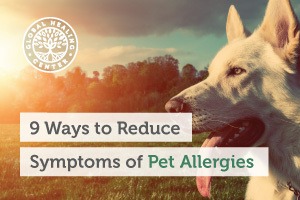
It might not surprise you to hear that as many as 70% of all American homes own a pet. Pets bring a lot of joy and are usually considered a true member of the family. Petting a cat or dog has been shown to lower blood pressure and decrease feelings of loneliness and isolation. It’s not hard to understand why we have a real emotional connection to our pets. However, for people with allergies to animal dander, pets can pose a concern.
Causes of Pet Allergies
Pet related allergies are often thought to be related to the actual hair, but it’s actually old skin scales that cause allergic reactions in humans. All animals are biological beings with systems constantly working. A byproduct of this existence is a regular, almost constant, shedding of old skin. Older animals are usually worse offenders than younger, and since dander is usually 2-3 microns in size, it can’t be seen by the naked eye; but is the perfect size to invade and cause disruption in the eyes, nose, or throat.
The small size of pet dander also means that it transfers easily. If you have a dog or cat in the house, it’s likely you can find your pet’s dander in the air, on clothing, bedding, in the curtains, furniture, and carpeting. Pet dander transfers so easily on clothing you don’t even have to own a pet in order to suffer from pet allergies.
The Effects of Pet Dander Allergies
Symptoms of an allergy to dander will usually present the classic allergy symptoms. Swollen glands, hives, sneezing, itchy eyes, watery eyes, nose congestion or runny nose, swollen face and skin, or general aches are all common. It should also be noted that the excretory droppings of animals can cause allergic reactions as well.
Ways to Reduce Symptoms of Pet Related Allergies At Home
- Designate one room as a "pet free zone.” Dander transfers easily but keeping at least one room off limit to pets, and by cleaning regularly, it’s possible to maintain a safe haven.
- Use a high quality air purifier. Pet dander is only 2-3 microns in size, and that’s small enough to float in the air for hours before settling.
- Use that accessibility to your advantage and purify the air in your home. A HEPA filtration unit or whole house air purification system works best.
- Clean your pet's bed or area regularly. Just as you wash your own bedding to prevent gross build up, you should keep your pets area clean.
- Clean upholstery often. Even if your pets aren’t allowed on the furniture, dander in the air can settle on furniture and be absorbed into upholstery.
- Dust with a wet cloth. Dry dusting stirs up dander, making it easier to breathe in.
- Clean drapes, curtains, rugs and carpets regularly with non toxic products.
- Wash your pets.
- Keep litter boxes covered.
Exposure is Everywhere
Most cases of pet allergies occur in homes where pets are living, but also happen in places where pets do not live. Pet allergens can be especially prevalent in schools, homes, shopping centers and places of work. It’s not possible to live in a bubble, but it is possible to take measures to reduce pet dander and pet related allergies in your home.
†Results may vary. Information and statements made are for education purposes and are not intended to replace the advice of your doctor. If you have a severe medical condition or health concern, see your physician.







